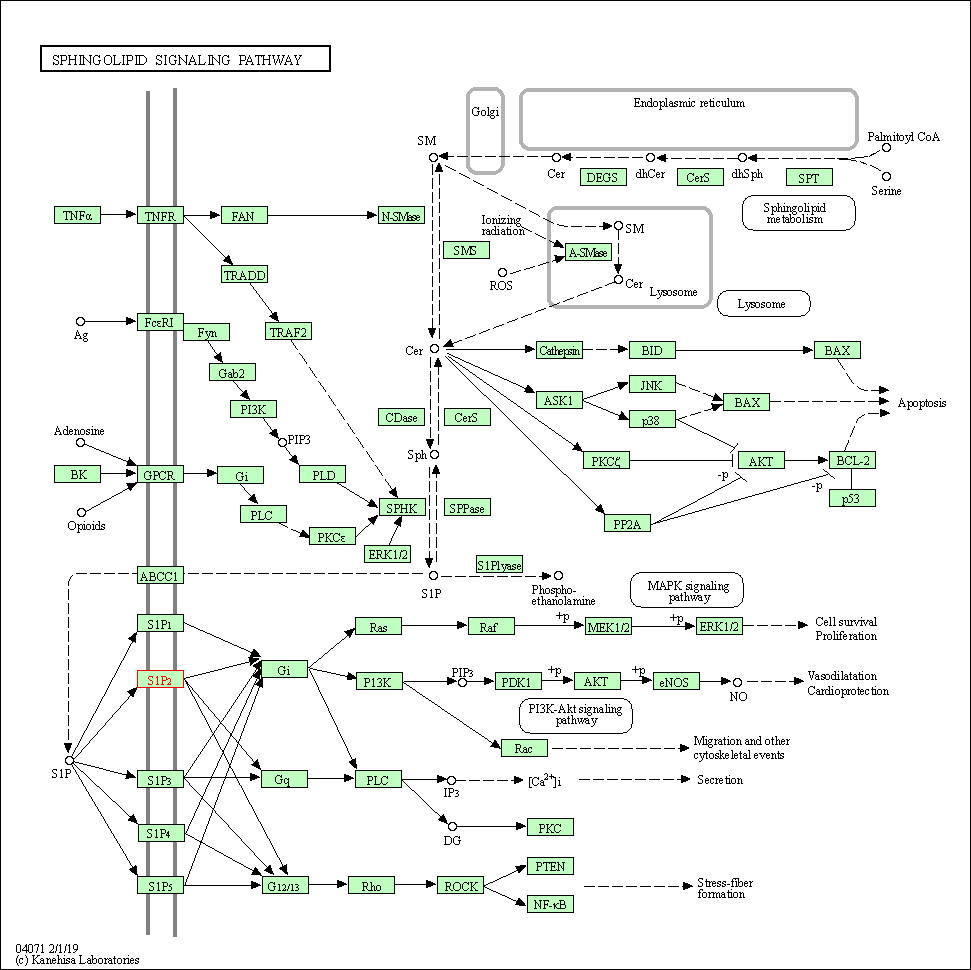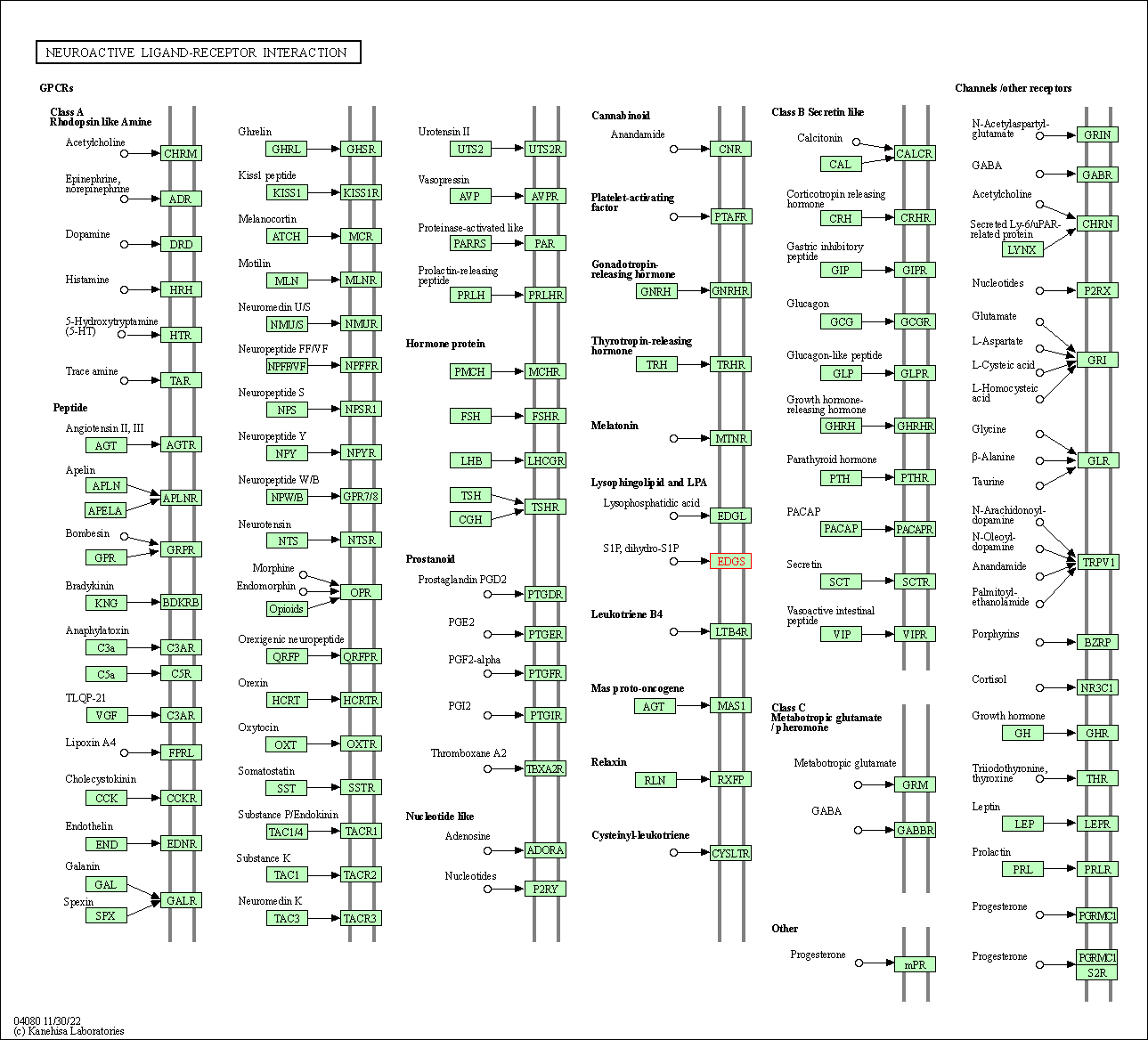Target Information
| Target General Information | Top | |||||
|---|---|---|---|---|---|---|
| Target ID |
T47888
(Former ID: TTDI02522)
|
|||||
| Target Name |
Sphingosine-1-phosphate receptor 2 (S1PR2)
|
|||||
| Synonyms |
Sphingosine 1-phosphate receptor Edg-5; S1PR2; S1P2; S1P receptor Edg-5; S1P receptor 2; Endothelial differentiation G-protein coupled receptor 5
Click to Show/Hide
|
|||||
| Gene Name |
S1PR2
|
|||||
| Target Type |
Clinical trial target
|
[1] | ||||
| Disease | [+] 1 Target-related Diseases | + | ||||
| 1 | Ulcerative colitis [ICD-11: DD71] | |||||
| Function |
Receptor for the lysosphingolipid sphingosine 1- phosphate (S1P). S1P is a bioactive lysophospholipid that elicits diverse physiological effect on most types of cells and tissues. When expressed in rat HTC4 hepatoma cells, is capable of mediating S1P-induced cell proliferation and suppression of apoptosis.
Click to Show/Hide
|
|||||
| BioChemical Class |
GPCR rhodopsin
|
|||||
| UniProt ID | ||||||
| Sequence |
MGSLYSEYLNPNKVQEHYNYTKETLETQETTSRQVASAFIVILCCAIVVENLLVLIAVAR
NSKFHSAMYLFLGNLAASDLLAGVAFVANTLLSGSVTLRLTPVQWFAREGSAFITLSASV FSLLAIAIERHVAIAKVKLYGSDKSCRMLLLIGASWLISLVLGGLPILGWNCLGHLEACS TVLPLYAKHYVLCVVTIFSIILLAIVALYVRIYCVVRSSHADMAAPQTLALLKTVTIVLG VFIVCWLPAFSILLLDYACPVHSCPILYKAHYFFAVSTLNSLLNPVIYTWRSRDLRREVL RPLQCWRPGVGVQGRRRGGTPGHHLLPLRSSSSLERGMHMPTSPTFLEGNTVV Click to Show/Hide
|
|||||
| 3D Structure | Click to Show 3D Structure of This Target | AlphaFold | ||||
| Drugs and Modes of Action | Top | |||||
|---|---|---|---|---|---|---|
| Clinical Trial Drug(s) | [+] 1 Clinical Trial Drugs | + | ||||
| 1 | Amiselimod | Drug Info | Phase 2 | Ulcerative colitis | [2] | |
| Mode of Action | [+] 3 Modes of Action | + | ||||
| Modulator | [+] 1 Modulator drugs | + | ||||
| 1 | Amiselimod | Drug Info | [3] | |||
| Inhibitor | [+] 6 Inhibitor drugs | + | ||||
| 1 | Jte 013 | Drug Info | [4] | |||
| 2 | SCHEMBL15295829 | Drug Info | [4] | |||
| 3 | Unii-R228S06soh | Drug Info | [4] | |||
| 4 | US8975409, Comparative compound B | Drug Info | [5] | |||
| 5 | US8975409, Example 13 | Drug Info | [5] | |||
| 6 | US8975409, Example 9(3) | Drug Info | [5] | |||
| Agonist | [+] 1 Agonist drugs | + | ||||
| 1 | AUY954 | Drug Info | [6] | |||
| Cell-based Target Expression Variations | Top | |||||
|---|---|---|---|---|---|---|
| Cell-based Target Expression Variations | ||||||
| Drug Binding Sites of Target | Top | |||||
|---|---|---|---|---|---|---|
| Ligand Name: Sphingosine-1-phosphate | Ligand Info | |||||
| Structure Description | Structure of S1PR2-heterotrimeric G13 signaling complex | PDB:7T6B | ||||
| Method | Electron microscopy | Resolution | 3.19 Å | Mutation | No | [7] |
| PDB Sequence |
NKVQEHYNYT
21 KTSRQVASAF39 IVILCCAIVV49 ENLLVLIAVA59 RNSKFHSAMY69 LFLGNLAASD 79 LLAGVAFVAN89 TLLSGSVTLR99 LTPVQWFARE109 GSAFITLSAS119 VFSLLAIAIE 129 RHVAIAKVKL139 YGSDKSCRML149 LLIGASWLIS159 LVLGGLPILG169 WNCLGHLEAC 179 STVLPLYAKH189 YVLCVVTIFS199 IILLAIVALY209 VRIYCVVRSS219 QTLALLKTVT 236 IVLGVFIVCW246 LPAFSILLLD256 YACPVHSCPI266 LYKAHYFFAV276 STLNSLLNPV 286 IYTW
|
|||||
|
|
TYR18
4.936
ARG33
3.691
ASN89
2.899
SER93
3.299
LEU98
3.571
ARG108
4.031
GLU109
3.375
ALA112
3.976
PHE113
3.532
LEU116
4.227
SER117
3.134
VAL120
4.497
|
|||||
| Click to View More Binding Site Information of This Target with Different Ligands | ||||||
| Different Human System Profiles of Target | Top |
|---|---|
|
Human Similarity Proteins
of target is determined by comparing the sequence similarity of all human proteins with the target based on BLAST. The similarity proteins for a target are defined as the proteins with E-value < 0.005 and outside the protein families of the target.
A target that has fewer human similarity proteins outside its family is commonly regarded to possess a greater capacity to avoid undesired interactions and thus increase the possibility of finding successful drugs
(Brief Bioinform, 21: 649-662, 2020).
Human Pathway Affiliation
of target is determined by the life-essential pathways provided on KEGG database. The target-affiliated pathways were defined based on the following two criteria (a) the pathways of the studied target should be life-essential for both healthy individuals and patients, and (b) the studied target should occupy an upstream position in the pathways and therefore had the ability to regulate biological function.
Targets involved in a fewer pathways have greater likelihood to be successfully developed, while those associated with more human pathways increase the chance of undesirable interferences with other human processes
(Pharmacol Rev, 58: 259-279, 2006).
Biological Network Descriptors
of target is determined based on a human protein-protein interactions (PPI) network consisting of 9,309 proteins and 52,713 PPIs, which were with a high confidence score of ≥ 0.95 collected from STRING database.
The network properties of targets based on protein-protein interactions (PPIs) have been widely adopted for the assessment of target’s druggability. Proteins with high node degree tend to have a high impact on network function through multiple interactions, while proteins with high betweenness centrality are regarded to be central for communication in interaction networks and regulate the flow of signaling information
(Front Pharmacol, 9, 1245, 2018;
Curr Opin Struct Biol. 44:134-142, 2017).
Human Similarity Proteins
Human Pathway Affiliation
Biological Network Descriptors
|
|
| KEGG Pathway | Pathway ID | Affiliated Target | Pathway Map |
|---|---|---|---|
| Sphingolipid signaling pathway | hsa04071 | Affiliated Target |

|
| Class: Environmental Information Processing => Signal transduction | Pathway Hierarchy | ||
| Neuroactive ligand-receptor interaction | hsa04080 | Affiliated Target |

|
| Class: Environmental Information Processing => Signaling molecules and interaction | Pathway Hierarchy | ||
| Degree | 5 | Degree centrality | 5.37E-04 | Betweenness centrality | 6.72E-05 |
|---|---|---|---|---|---|
| Closeness centrality | 2.13E-01 | Radiality | 1.37E+01 | Clustering coefficient | 2.00E-01 |
| Neighborhood connectivity | 4.38E+01 | Topological coefficient | 2.31E-01 | Eccentricity | 12 |
| Download | Click to Download the Full PPI Network of This Target | ||||
| Chemical Structure based Activity Landscape of Target | Top |
|---|---|
| Drug Property Profile of Target | Top | |
|---|---|---|
| (1) Molecular Weight (mw) based Drug Clustering | (2) Octanol/Water Partition Coefficient (xlogp) based Drug Clustering | |
|
|
||
| (3) Hydrogen Bond Donor Count (hbonddonor) based Drug Clustering | (4) Hydrogen Bond Acceptor Count (hbondacc) based Drug Clustering | |
|
|
||
| (5) Rotatable Bond Count (rotbonds) based Drug Clustering | (6) Topological Polar Surface Area (polararea) based Drug Clustering | |
|
|
||
| "RO5" indicates the cutoff set by lipinski's rule of five; "D123AB" colored in GREEN denotes the no violation of any cutoff in lipinski's rule of five; "D123AB" colored in PURPLE refers to the violation of only one cutoff in lipinski's rule of five; "D123AB" colored in BLACK represents the violation of more than one cutoffs in lipinski's rule of five | ||
| Target Poor or Non Binders | Top | |||||
|---|---|---|---|---|---|---|
| Target Poor or Non Binders | ||||||
| Target Affiliated Biological Pathways | Top | |||||
|---|---|---|---|---|---|---|
| KEGG Pathway | [+] 2 KEGG Pathways | + | ||||
| 1 | Sphingolipid signaling pathway | |||||
| 2 | Neuroactive ligand-receptor interaction | |||||
| PID Pathway | [+] 3 PID Pathways | + | ||||
| 1 | S1P3 pathway | |||||
| 2 | Sphingosine 1-phosphate (S1P) pathway | |||||
| 3 | S1P2 pathway | |||||
| Reactome | [+] 2 Reactome Pathways | + | ||||
| 1 | G alpha (i) signalling events | |||||
| 2 | Lysosphingolipid and LPA receptors | |||||
| WikiPathways | [+] 4 WikiPathways | + | ||||
| 1 | Signal Transduction of S1P Receptor | |||||
| 2 | Small Ligand GPCRs | |||||
| 3 | GPCR ligand binding | |||||
| 4 | GPCR downstream signaling | |||||
| References | Top | |||||
|---|---|---|---|---|---|---|
| REF 1 | URL: http://www.guidetopharmacology.org Nucleic Acids Res. 2015 Oct 12. pii: gkv1037. The IUPHAR/BPS Guide to PHARMACOLOGY in 2016: towards curated quantitative interactions between 1300 protein targets and 6000 ligands. (Target id: 276). | |||||
| REF 2 | ClinicalTrials.gov (NCT04857112) A Phase 2, Randomized, Double-Blinded, Placebo Controlled, Parallel Group Study Evaluating the Efficacy and Safety of Amiselimod (MT-1303) in Subjects With Mild to Moderate Ulcerative Colitis (UC). U.S.National Institutes of Health. | |||||
| REF 3 | Amiselimod, a novel sphingosine 1-phosphate receptor-1 modulator, has potent therapeutic efficacy for autoimmune diseases, with low bradycardia risk. Br J Pharmacol. 2017 Jan;174(1):15-27. | |||||
| REF 4 | Sphingosine 1-phosphate receptor antagonists. US9663511. | |||||
| REF 5 | Phenyl derivative. US8975409. | |||||
| REF 6 | A monoselective sphingosine-1-phosphate receptor-1 agonist prevents allograft rejection in a stringent rat heart transplantation model. Chem Biol. 2006 Nov;13(11):1227-34. | |||||
| REF 7 | Structure of S1PR2-heterotrimeric G(13) signaling complex. Sci Adv. 2022 Apr;8(13):eabn0067. | |||||
If You Find Any Error in Data or Bug in Web Service, Please Kindly Report It to Dr. Zhou and Dr. Zhang.

